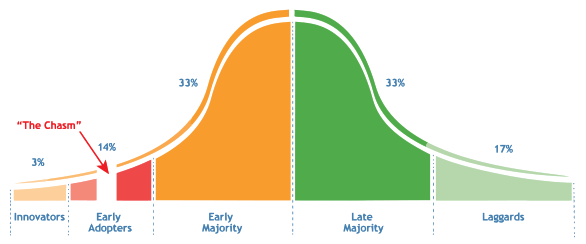Technology Adoption Life Cycle
There's a good chance that if you've been around new technology, you've heard about the technology adoption life cycle. This model is used to explain how people respond to product and service innovations that require the end user to change their past behavior. Under this model, consumers self-segregate along an axis of risk aversion with the risk-takers (innovators) on one end and the risk averse (laggards) on the other. In between these two extremes are the early adopters, early majority, and later majority.

The best description of this model that I've ever read came from Geoffrey A. Moore's Inside the Tornado — a book from 1995. In his book he defined the 5 segments as follows:
Innovators
These are the people who are fundamentally committed to new technology on the grounds that, sooner or later, it is bound to improve our lives. The person you turn to with technology questions is likely someone that falls in to the innovators group.
Early Adopters
These are the true revolutionaries in business and government who want to use the discontinuity of any innovation to make a break with the past and start an entirely new future. Their expectation is that by being first to exploit the new capability they can achieve dramatic and insurmountable competitive advantage over the old order.
Early Majority
These people make the bulk of all technology infrastructure purchases. They do not love technology for its own sake, so are different from the techies, whom they are careful, nonetheless, to employ. Moreover, they believe in evolution not revolution. They are interested in making their company's systems work effectively and look to adopt innovations only after they have established a proven track record.
Late Majority
These consumers are pessimistic about their ability to gain any value from technology investments and undertake them only under duress — typically because the remaining alternative is to let the rest of the world pass them by. They are very price-sensitive, highly skeptical, and very demanding. Rarely do their demands get met, in part because they are unwilling to pay for any extra services, all of which only reconfirms their sour views of high tech.
Laggards
This group delight in challenging the hype and puffery of high-tech marketing. They are not so much potential customers as ever-present critics. As such, the goal of high-tech marketing is not to sell to them but rather to sell around them.
The Marketing Strategy
With these customer segments in mind, the typical approach is to seed new products with the innovators so they can help educate the early adopters. When the early adopter's are interested, do everything that is possible to make them happy as they will then serve as references for the early majority which is the group where most of the money is made from a new product or service. Then leverage the success with this large group so that the product matures and stabilizes enough to be of interest to the late adopters. All the while, ignore the laggards and their skepticism.
Sounds good, right? A remarkable model that will guarantee success. Too bad it's flawed.
Geoffrey A. Moore goes on to explain in his book that the model is flawed in that it fails to describe a particular phase that he dubs the chasm.
The problem with the model is that it fails to explain the real-world problems that companies encounter in getting their product to move from the early adopters (visionaries) to the early majority (pragmatists). This transition being important because it is the early majority that brings in the millions and billions of dollars that put companies on the map. The problem stems from visionaries being poorly regarded by pragmatists and thus failing to serve as a valued endorsement for an emerging product or service. This difference in ideology ends up causing companies to fall in to a chasm where they run the risk of going out of business.
Geoffrey suggests that the idea of the chasm is a simple one. He writes:
“It says that whenever truly innovative high-tech products are first brought to market, they will enjoy a warm welcome in an early market made up of technology enthusiasts and visionaries but then will fall into a chasm, during which sales will falter and often plummet. If the products can successfully cross this chasm, they will gain acceptance within a mainstream market dominated by pragmatists and conservatives. Since for product-oriented enterprises virtually all high-tech wealth comes from this third phase of market development, crossing the chasm becomes an organizational imperative.”
The secret to crossing the chasm is understanding one key difference between the two markets on either side of it. On the one side is a group that is willing to accept a solution that is 80% complete because of the potential it promises. On the other side is a group that wants a solution that is 100% complete. Of course, a 100% complete product that serves all market segments is an impossible to achieve goal for a company at this stage in its development. Thus, the strategy is to build a complete product but only for a particular market segment. When enough individual segments have been brought on board each with their respective whole product, the company will then be in a position to step out of the chasm and have at the ready a product ready for the mainstream.
There's no question that on paper this approach seems simple. Of course, it glosses over the execution problems that are inevitable. Still, it seems that Geoffrey has certainly come up with an important piece of the puzzle in moving from an unknown startup to a well-established enterprise.




Who the f...s Marios Alexandrou? Sorry, only kidding - being a mature university student [aged 61] and attempting to respond to some seemingly dumb sociological questions regarding whether anti-progress people should be called Luddites or not. This article was inspirational to me.
Muchos gracias.